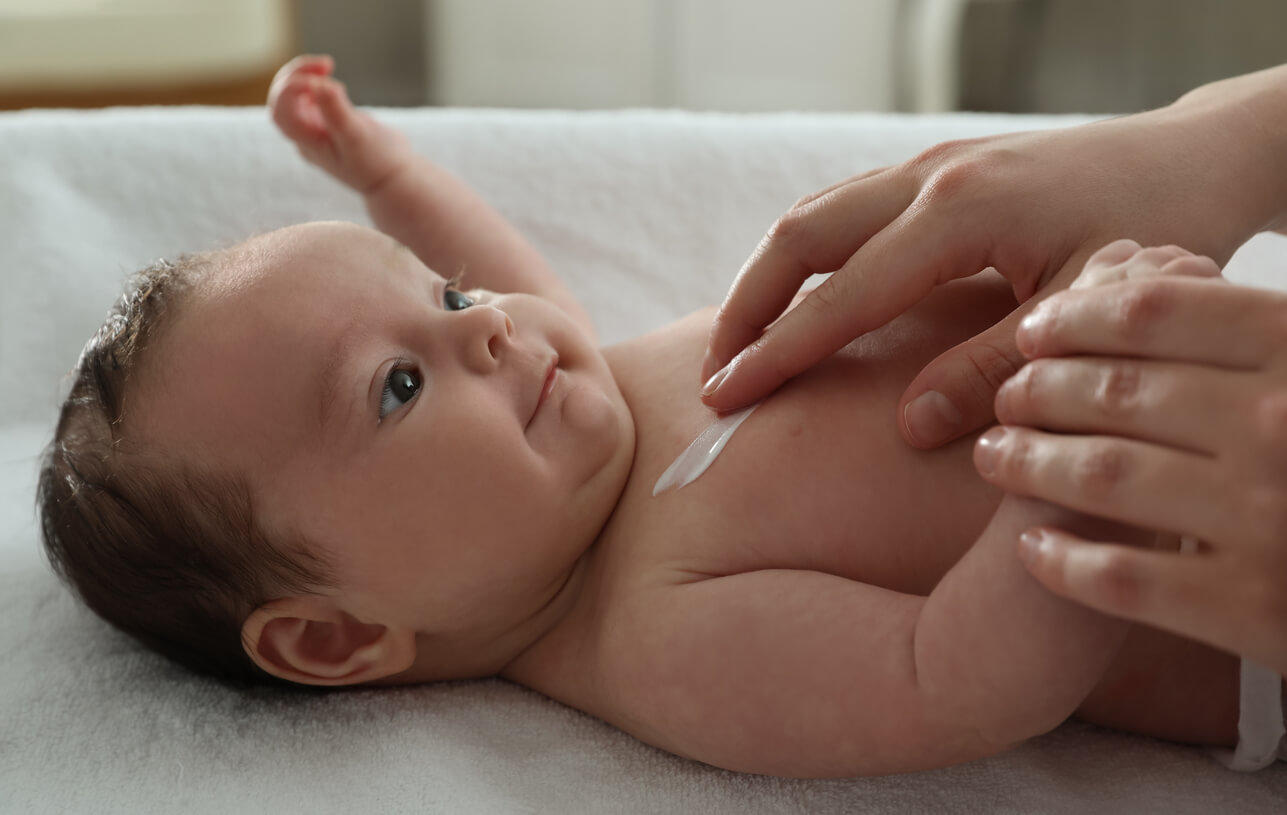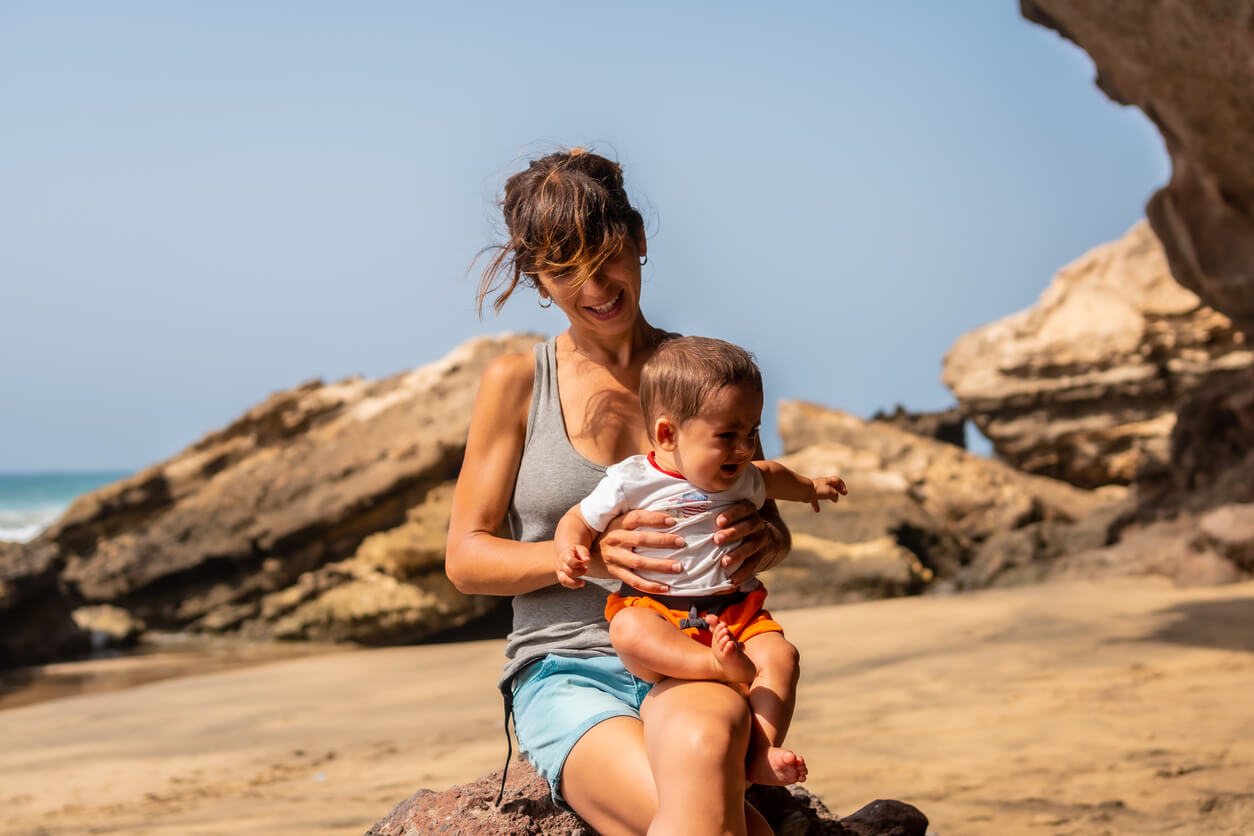Is Sunscreen Safe for Babies Under Six Months Old?


Written and verified by the dermatologist Maria del Carmen Hernandez
Whenever you want to take a walk outdoors with a newborn, you should avoid direct exposure to ultraviolet rays. But is sunscreen safe for babies under six months old? Is any type of sunscreen suitable? In this article, we’ll explain what considerations you should take into account when out in the sun with your little ones and which sunscreen products are the most suitable.
Types of sunscreen
Photoprotection involves both primary and secondary protective factors. The first are sunscreens, which include physical barriers that reflect and scatter light, as well as chemical barriers, which absorb it.
Sunscreens with non-organic or physical filters
Physical sunscreens reflect and scatter ultraviolet light in the same way as clothing. In general, they consist of zinc oxide, titanium dioxide, kaolin, calcium carbonate, and magnesium oxide. However, there are some newer chemical compounds that are broad-spectrum:
- Bemotrizinol
- Avobenzone
- Oxybenzone
- Octotrilene
Mineral sunscreens are the most effective and safest. Although they remain on the skin surface as a uniform white layer, they act as a screen that reflects light.
Sunscreens with organic or chemical filters
These have a chemical structure that allows the sun’s high-energy rays to be absorbed. Therefore, this type of sunscreen isn’t considered safe for babies, as the skin absorbs all the substances and may develop irritations or allergies. In general, sun creams are composed of parabens, perfumes, or preservatives that are often harmful to the sensitive skin of newborns.

Is it safe to apply sunscreen to babies under 6 months of age?
The FDA doesn’t consider the application of sunscreen on infants under 6 months of age to be safe. This is due to the lack of development of infant metabolism and excretion of absorbed sunscreen chemical actives. While zinc oxide is the only active ingredient that has been proven to be safe in infants, titanium dioxide is also advised. Both are components of physical sunscreens. On the other hand, those containing chemical names and parabens aren’t recommended. In fact, there are some with antioxidants that enhance their function, such as the following:
- Green tea
- Vitamin E
- Shea butter
The skin surface of babies is much thinner than that of adults. It even has a greater permeability to substances and a lower amount of pigment that makes it more susceptible to the sun’s rays.
Sun protection measures for babies under six months of age
Photoprotection is indicated to reduce skin damage caused by ultraviolet radiation, along with malignant skin lesions. In fact, recurrent and severe sunburns are a risk factor for non-melanoma skin cancer.
Wear hats
Hats are a variable form of photoprotection depending on brim width, fabric, and material. However, it’s important to keep newborns in the shade as much of the time as possible. At the same time, wide-brimmed hats help protect areas of the body such as the ears, nose, and neck.
Opt for sun-protective clothing
The UV protection provided by clothing depends on the porosity and texture of the fabric or whether it’s wet or dry. In other words, moisture in the fabric decreases the UV protection capacity, as does a stretched fabric. In addition, denim has a much higher protection factor than cotton.

Avoid extreme hours
The American Academy of Pediatrics recommends keeping babies under six months of age away from direct exposure to ultraviolet rays. In addition, it’s best to avoid sun exposure during the day (from 10 am to 4 pm) and to take advantage of shade under a tree or use an umbrella. However, the sun’s rays can reflect on different surfaces and reach the skin even when you’re in the shade.
Use sunglasses with UV filters
Sunglasses are an effective form of photoprotection for the eyes. It’s important to keep in mind that sun exposure can cause various eye conditions, such as cataracts. They should also absorb 99% to 100% of the full UV spectrum, have dark lenses, and be approved.
Sunscreens for babies as a last resort
Ideally, you shouldn’t need to use sunscreen for babies under six months of age, as it’s not safe to expose them directly to ultraviolet rays. However, if you must, physical sunscreens are the most appropriate.
Remember that even if you stay in the shade or under an umbrella, the sun’s rays have the ability to reflect off different surfaces, such as water, sand, and snow, and cause damage.
Whenever you want to take a walk outdoors with a newborn, you should avoid direct exposure to ultraviolet rays. But is sunscreen safe for babies under six months old? Is any type of sunscreen suitable? In this article, we’ll explain what considerations you should take into account when out in the sun with your little ones and which sunscreen products are the most suitable.
Types of sunscreen
Photoprotection involves both primary and secondary protective factors. The first are sunscreens, which include physical barriers that reflect and scatter light, as well as chemical barriers, which absorb it.
Sunscreens with non-organic or physical filters
Physical sunscreens reflect and scatter ultraviolet light in the same way as clothing. In general, they consist of zinc oxide, titanium dioxide, kaolin, calcium carbonate, and magnesium oxide. However, there are some newer chemical compounds that are broad-spectrum:
- Bemotrizinol
- Avobenzone
- Oxybenzone
- Octotrilene
Mineral sunscreens are the most effective and safest. Although they remain on the skin surface as a uniform white layer, they act as a screen that reflects light.
Sunscreens with organic or chemical filters
These have a chemical structure that allows the sun’s high-energy rays to be absorbed. Therefore, this type of sunscreen isn’t considered safe for babies, as the skin absorbs all the substances and may develop irritations or allergies. In general, sun creams are composed of parabens, perfumes, or preservatives that are often harmful to the sensitive skin of newborns.

Is it safe to apply sunscreen to babies under 6 months of age?
The FDA doesn’t consider the application of sunscreen on infants under 6 months of age to be safe. This is due to the lack of development of infant metabolism and excretion of absorbed sunscreen chemical actives. While zinc oxide is the only active ingredient that has been proven to be safe in infants, titanium dioxide is also advised. Both are components of physical sunscreens. On the other hand, those containing chemical names and parabens aren’t recommended. In fact, there are some with antioxidants that enhance their function, such as the following:
- Green tea
- Vitamin E
- Shea butter
The skin surface of babies is much thinner than that of adults. It even has a greater permeability to substances and a lower amount of pigment that makes it more susceptible to the sun’s rays.
Sun protection measures for babies under six months of age
Photoprotection is indicated to reduce skin damage caused by ultraviolet radiation, along with malignant skin lesions. In fact, recurrent and severe sunburns are a risk factor for non-melanoma skin cancer.
Wear hats
Hats are a variable form of photoprotection depending on brim width, fabric, and material. However, it’s important to keep newborns in the shade as much of the time as possible. At the same time, wide-brimmed hats help protect areas of the body such as the ears, nose, and neck.
Opt for sun-protective clothing
The UV protection provided by clothing depends on the porosity and texture of the fabric or whether it’s wet or dry. In other words, moisture in the fabric decreases the UV protection capacity, as does a stretched fabric. In addition, denim has a much higher protection factor than cotton.

Avoid extreme hours
The American Academy of Pediatrics recommends keeping babies under six months of age away from direct exposure to ultraviolet rays. In addition, it’s best to avoid sun exposure during the day (from 10 am to 4 pm) and to take advantage of shade under a tree or use an umbrella. However, the sun’s rays can reflect on different surfaces and reach the skin even when you’re in the shade.
Use sunglasses with UV filters
Sunglasses are an effective form of photoprotection for the eyes. It’s important to keep in mind that sun exposure can cause various eye conditions, such as cataracts. They should also absorb 99% to 100% of the full UV spectrum, have dark lenses, and be approved.
Sunscreens for babies as a last resort
Ideally, you shouldn’t need to use sunscreen for babies under six months of age, as it’s not safe to expose them directly to ultraviolet rays. However, if you must, physical sunscreens are the most appropriate.
Remember that even if you stay in the shade or under an umbrella, the sun’s rays have the ability to reflect off different surfaces, such as water, sand, and snow, and cause damage.
All cited sources were thoroughly reviewed by our team to ensure their quality, reliability, currency, and validity. The bibliography of this article was considered reliable and of academic or scientific accuracy.
- U.S. Food & Drug Administration. Should you put sunscreen on Infants? Not usually. FDA website [Internet]. 2021. Acceso 24 septiembre 2021. Disponible en: https://www.fda.gov/consumers/consumer-updates/should-you-put-sunscreen-infants-not-usually
- American Academy of Pediatrics. Sun Safety. Information for Parents about Sunburn & Sunscreen. Website [Internet]. 2021. Acceso 24 septiembre 2021. Disponible en: https://www.healthychildren.org/English/safety-prevention/at-play/Pages/Sun-Safety.aspx
- Julian E, Palestro AM, Thomas JA. Pediatric Sunscreen and Sun Safety Guidelines. Clin Pediatr (Phila). 2015 Oct;54(12):1133-40. doi: 10.1177/0009922815591889. Epub 2015 Jun 29. PMID: 26130395.
- Li H, Colantonio S, Dawson A, Lin X, Beecker J. Sunscreen Application, Safety, and Sun Protection: The Evidence. J Cutan Med Surg. 2019 Jul/Aug;23(4):357-369. doi: 10.1177/1203475419856611. Epub 2019 Jun 20. PMID: 31219707.
- Fransway AF, Fransway PJ, Belsito DV, Yiannias JA. Paraben Toxicology. Dermatitis. 2019 Jan/Feb;30(1):32-45. doi: 10.1097/DER.0000000000000428. PMID: 30570577.
- Serpone N. Sunscreens and their usefulness: have we made any progress in the last two decades? Photochem Photobiol Sci. 2021 Feb;20(2):189-244. doi: 10.1007/s43630-021-00013-1. Epub 2021 Feb 18. PMID: 33721254.
This text is provided for informational purposes only and does not replace consultation with a professional. If in doubt, consult your specialist.








